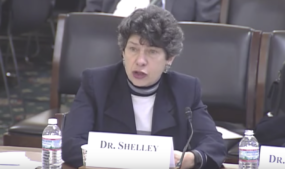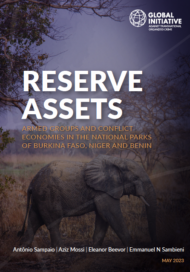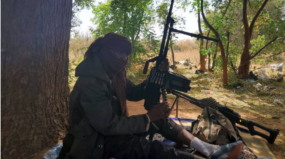Posted on 09 Mar 2014
Academic and author Louise Shelley was driven to create the Washington-based Terrorism, Transnational and Corruption Center (TraCCC) in the mid-1990s because of her longstanding belief in the connection among the three phenomena.
She has published widely on these topics, and her latest book, due out in mid-2014, entitled Dirty Entanglements: Corruption, Crime and Terrorism, is to be published by Cambridge University Press. Shelley’s eventful career has taken her to many parts of the world, including Russia, where she studied criminology at Moscow State University in the mid-1970s. Among her special interests are crime in post-Soviet states and human trafficking, on which she has published several books and numerous articles and book chapters.
Shelley’s interest in illicit networks and specifically, the relationships among them, dates back to her childhood. At the dinner table her father, an international stamp collector in the days before easy wire transfers would describe how he was approached by emissaries of corrupt Latin American dictators who asked him to move stamps to the financial haven of Switzerland. “I learned early on how commodities were used to move illicit money around and my father’s abhorrence of this corruption taught me important morality lessons” says Shelley. Her father owned real estate in New York city in the 1950s at a time that the mafia was a major landowner. His discussion of his encounters with organized crime also contributed to her early awareness of the problem. Shelley hails from a scientific family, and believes her strong math and science bent has contributed to her understanding of TOC. “Unlike robberies, which tend to be random acts of crime, the people doing TOC are very rational actors who use a lot of analysis. It takes a lot of rationality to analyze it,” she says.
Shelley has two grown children and lives in Washington, DC. She and her partner, a physicist both share an avid interest in textiles and carpets. She describes herself as a “culture vulture”: “I like art and things that are visually beautiful,” she says, which provides a welcome diversion from analyzing crime and terrorism. However, she is unable to stray from her field for long and has even given a talk entitled, “Drugs, Bugs, Thugs and Rugs,” on the connection between rug collecting and crime in Central Asia. Shelley also devotes time to keeping up her fluency in several languages which is a pleasure and not a chore.
As part of its series profiling members, the Global Initiative asked Shelley to share her views on trends in organized crime and efforts to combat it.
 1. Which in your view is more of a threat to global peace and stability – terrorism or TOC? The US’s focus on TOC ended after 9/11. Although its TOC strategy declares a link between TOC and terrorism, its terrorism strategy does not – even though the two are deeply linked. You may have TOC without terrorism but these days you can’t have terrorism without TOC, given that logistical support for terrorism comes from criminals or links with criminals. There are more linkages between TOC and terrorism today than when I started studying these phenomena. In my view, TOC is not getting the resources or attention it needs in the US, partly because the bureaucratic structures are so stove-piped. We are seeing much more attention on the problem of TOC outside the US. For example, the Colombian government is pressing the UN and Organization of American States (OAS) to recognize these linkages. This is not an agenda being driven by developed countries but rather by the developing world.
1. Which in your view is more of a threat to global peace and stability – terrorism or TOC? The US’s focus on TOC ended after 9/11. Although its TOC strategy declares a link between TOC and terrorism, its terrorism strategy does not – even though the two are deeply linked. You may have TOC without terrorism but these days you can’t have terrorism without TOC, given that logistical support for terrorism comes from criminals or links with criminals. There are more linkages between TOC and terrorism today than when I started studying these phenomena. In my view, TOC is not getting the resources or attention it needs in the US, partly because the bureaucratic structures are so stove-piped. We are seeing much more attention on the problem of TOC outside the US. For example, the Colombian government is pressing the UN and Organization of American States (OAS) to recognize these linkages. This is not an agenda being driven by developed countries but rather by the developing world.
However, no institution is addressing what I see as the central problem – the relationship among corruption, TOC and terrorism.
2. What can be done about this three-pronged problem? We need to change the structures of state and multilateral organizations to address this. Also we need to take a “whole of society” approach that is not just about governments acting against this problem but that also includes multilaterals, business, the media, researchers and NGOs. As with physics, when you’re dealing with a “three-body” problem, you can have off-the-charts, unexpected and chaotic consequences, which we are seeing in certain parts of the world, like Afghanistan, Iraq and Syria. We have to look at the problems holistically and find out where the trends are. I see them as consequences of much larger social forces like increasing economic disparity, the youth population bulge and climate change and our ability to impact them are more limited than one might hope.
3. What are some other challenges faced by those trying to combat TOC? TOC is moving into underpoliced areas of criminal activity. A big thing we’re seeing nowadays is their involvement in counterfeiting – not just that relating to intellectual property but to counterfeit pharmaceuticals, with enormous health implications. Also the illicit trade in wildlife is not just eliminating species but impacting other species in the animal chain and contributing to the spread of disease. We are dealing with problems that threaten the very sustainability of the planet, yet we are not focusing on these areas and the transcendental threat they pose. Instead, we are concentrating way too exclusively on the drug trade. Another area where we need to turn our attentions is art smuggling which is very deleterious to our culture and historical patrimony.
 4. You’ve written extensively on human trafficking. How did you become interested in this aspect of TOC and how bad is the problem today? When I was in the Soviet Union in the late 1980s I saw the enormous rise of prostitution where educated women were surrounded by men who looked like gorillas. This clearly wasn’t voluntary activity. At the same time, I was invited to write a curriculum on crime in Thailand for a major university and there I witnessed the massive phenomenon of young, uneducated girls being trafficked for sex. It helped me to understand the many different forms that trafficking can take. According to some estimates, around 30 million people are trafficked worldwide although I would say it’s probably fewer than that. Human trafficking is being driven by economic disparity, climate change, conflict, sectarian and ethnic violence. For these reasons the supply of humans is endless. We can go after the recruiting networks, follow the money and get the business community more deeply engaged but our efforts will meet with limited success unless we can address the conditions that create the enormous potential supply of victims.
4. You’ve written extensively on human trafficking. How did you become interested in this aspect of TOC and how bad is the problem today? When I was in the Soviet Union in the late 1980s I saw the enormous rise of prostitution where educated women were surrounded by men who looked like gorillas. This clearly wasn’t voluntary activity. At the same time, I was invited to write a curriculum on crime in Thailand for a major university and there I witnessed the massive phenomenon of young, uneducated girls being trafficked for sex. It helped me to understand the many different forms that trafficking can take. According to some estimates, around 30 million people are trafficked worldwide although I would say it’s probably fewer than that. Human trafficking is being driven by economic disparity, climate change, conflict, sectarian and ethnic violence. For these reasons the supply of humans is endless. We can go after the recruiting networks, follow the money and get the business community more deeply engaged but our efforts will meet with limited success unless we can address the conditions that create the enormous potential supply of victims.
5. Why is the Global Initiative so important? An initiative that brings people from diverse types of societies and cultures together is really crucial in that it will provide different perspectives. It’s very important that the GI is not dominated by specialists from the developed world. So many efforts to address TOC are often led by individuals from developed countries that so often want to put the blame for TOC exclusively on fragile states or conflict regions. They fail to acknowledge the shared responsibility—the developed countries that provide safe havens for the stolen loot of kleptocrats or the ransom payments paid by governments or insurance companies to crime/terror groups in the developing world to free victims of kidnapping.
[wpfilebase tag=file id=640 /]


